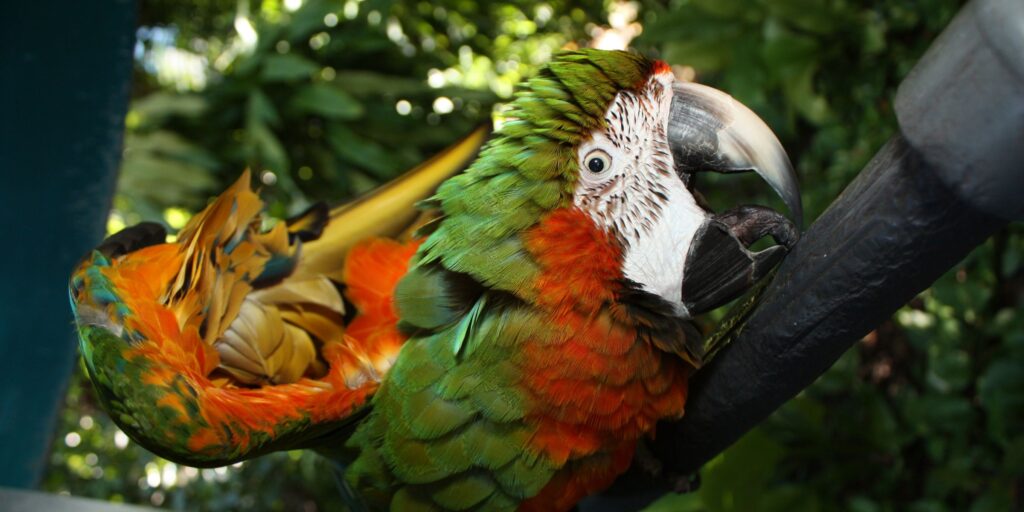Catalina Macaw (Appearance, Personality, Caring, Diet, and Health)
Last Updated on January 22, 2024 by Ali Shahid
The Catalina Macaw, also called the Rainbow Macaw, is a fascinating mix of a Blue-and-Gold Macaw and a Scarlet Macaw. This colorful bird was first created in 1940 at Catalina Bird Park in California. It’s a result of careful breeding. The Catalina Macaw looks amazing with its mix of orange, yellow, green, and blue colors.
Not only do they look stunning, but they are also quite big, weighing 2-3 pounds and reaching up to 35 inches in length. As pets, Catalina Macaws are known for being happy, smart, and social.
They can live for 50 to 60 years in captivity, so owning one is a long-term commitment. You can buy a Catalina Macaw from GoldenCockatoo, HookBills for Sale, or ExoticanimalsforSaleOnline for around $5500-$6000. They make great pets for experienced bird owners who know how to take care of them. Catalina macaws are rainbow beauties that you may want to learn more about. So here is a complete article about this hybrid beauty.

| Category | Details |
| Origin | Hybrid of Blue and Gold Macaw and Scarlet Macaw, primarily found in captivity |
| Appearance | Vibrant coloration with orange-red head and chest, green and blue wings, pinkish-white chin with black patches. Strong, curved beak and grey legs |
| Size | Large parrots, around 34-35 inches in length with a wingspan of 40-45 inches. Weight between 2-3 pounds |
| Lifespan | A balanced diet of a variety of seeds, plants, fruits, and nuts. Fresh fruits and vegetables are essential |
| Diet | Highly intelligent and sociable, responds well to training, forms strong bonds with human companions. Require regular mental stimulation and social interaction |
| Behavior | Highly intelligent and sociable, responds well to training, forms strong bonds with human companions. Require regular mental stimulation and social interaction |
| Health | Common health problems include Proventricular Dilation Disease, Psittacosis, kidney disease, papillomas, infections, and beak malformations. Regular vet check-ups are crucial |
| Breeding | Used to breed other hybrid macaws, considered first-generation hybrids |
| Conservation | Parent species face conservation concerns. Hybrid macaws bred in captivity have been used in conservation efforts |
| Price | Varies based on factors such as age, health, and location of the seller. Prices can range from $5500 to over $6,000 |
Catalina Macaw as a Hybrid Species
The Catalina Macaw is a cool mix of a Blue-and-Gold Macaw and a Scarlet Macaw. They don’t naturally happen in the wild but are often made through careful breeding. The first Catalina Macaw was born in 1940 in Catalina Bird Park, California, and that’s how it got its name.
These birds are a first-generation mix, meaning their parents are two different types of Macaws. Usually, the dad is a Scarlet Macaw, and the mom is a Blue-and-Gold Macaw, giving
Catalina Macaw its cool colors and a friendly personality. Catalina Macaws are known for their bright feathers, ranging from red or orange on their chests to green and blue on their backs and tails. People often breed them for these colors, but there can be slight differences from one generation to the next.
If you breed two Catalina Macaws together, you might get a second-generation mix like the Camelot Macaw, which is a mix of a Catalina Macaw and a Scarlet Macaw. However, the behavior of second-generation mixes can be a bit more unpredictable.
Behavior and Personality Traits of Catalina Macaw
Catalina Macaws stands out for their lively colors and delightful personalities. They’re cheerful, and energetic, and can be a bit demanding, needing time, experience, and patience from their owners. In their playful and active nature, they may get a bit rowdy during adolescence. Their behavior can swing from being socially needy to charmingly affectionate, influenced by their upbringing.
When it comes to socializing, Catalina Macaws are highly social birds. They form strong bonds with their owners, sometimes favoring either men or women exclusively. Properly introduced, they get along well with other Macaws. In the wild, Macaws form flocks, communicating with each other through loud calls, squawks, and screams.
These birds are smart and respond well to training. Catalina Macaws can learn tricks and even a vocabulary of around 15 words and phrases throughout their lives. Their stable temperaments make them less prone to neurotic behaviors, allowing them to focus on learning. They’re affectionate, intelligent birds that easily connect with their owners and grasp a variety of phrases.
Catalina Macaw as a Pet
Before deciding to have a Catalina Macaw as a pet, there are important things to think about. These birds are known for their bright colors and friendly attitude, but they have specific needs and behaviors to consider.
Firstly, Catalina Macaws can be costly to buy and take care of. You need to be ready for the initial expenses, like a big cage and special food. They can also be loud, which might not be suitable for apartments or if you don’t like noise. These birds are social and demand a lot of attention. In the wild, they live in groups and stick with one partner for life. At home, they’ll want to be with the family all the time. They’re clever and active, so you’ll need various toys and activities to keep them entertained.
When it comes to housing, Catalina Macaws need a spacious cage made of powder-coated metal, and they like a variety of toys. The cage should be at least 30″ x 40″ x 66″, with bar spacing between 1″ – 1 1/4″. They prefer an environment with a temperature between 60°F-70°F and need regular baths or showers.
Now, let’s talk about common issues. Catalina Macaws might lunge, bite, or make a lot of noise, especially if left alone. They could also chew on your things, causing damage. To deal with these behaviors, consistent and patient training is key. For instance, you can discourage too much noise by not reacting to it and rewarding quiet moments. Training them to climb on a stick can prevent aggression. Since they love food, using treats as rewards can be effective in training them to do what they want.
Diet and Nutrition of Catalina Macaw
Catalina Macaws, just like other macaws, eat a mix of fruits, nuts, seeds, and veggies in the wild. They need more fat than many other birds, especially from nuts and seeds. In captivity, it’s important to give them a balanced diet, including pellets made for birds to meet all their nutritional needs. About 20-25% of their daily diet can be fruits, veggies, and greens. Nuts, high in fats and oils, should be given in small amounts.
Having a balanced diet is super important for Catalina Macaws’ health. Bad nutrition can lead to issues like feather picking, and a good diet can help them live up to 50 years. Problems like lacking vitamins or malnutrition can cut down their life expectancy.
There are some foods Catalina Macaws should steer clear of. Artificial sweeteners like Xylitol, found in sugarless gum, can lead to serious problems. Avocados have a substance called persin in their leaves, which can be harmful. Chocolate is a no-go for birds. Also, anything processed, salty, or sweet should only be given in tiny amounts to keep them healthy.
Pros and Cons of Catalina Macaw
| Advantages | Disadvantages |
| Striking and colorful appearance | Tendency to produce loud noises, which may not be suitable for all living situations |
| Capable of mimicking human sounds due to their intelligence | Need for constant interaction and attention |
| Longevity, with a lifespan of 50 to 60 years in captivity | High maintenance in terms of care |
| Ability to form strong bonds with human companions and respond well to training | Potential for over-bonding issues if not properly socialized |
| Used in the breeding of other hybrid macaws | Possess powerful beaks that can be intimidating and potentially harmful |
| Their unique personality and charm can provide a rewarding experience for the owner | High cost, with prices ranging from $800 to over $5,000 |
| Contribute to the diversity and beauty of the macaw species | Susceptible to health problems, including Proventricular Dilation Disease, Psittacosis, kidney disease, papillomas, infections, and beak malformations |
Health and Lifespan of Catalina Macaw
Catalina Macaws typically live around 50 to 60 years in captivity, but with proper care, they might even reach 80 years. These birds can face health issues like Proventricular Dilation Disease, Psittacosis, kidney problems, papillomas, infections, and beak malformations. Watch out for signs like feather picking, a droopy body, swollen eyelids, and watery eyes as they could indicate serious health troubles. Providing a balanced diet with top-notch pellets, fresh fruits, and veggies is crucial because poor nutrition is a common cause of bird health problems.
Regular visits to the vet are a must for Catalina Macaws. Surprisingly, 30% of seemingly healthy birds have hidden infectious or inflammatory diseases, so regular vet check-ups help catch and treat issues early, ensuring a longer and better life for the bird.
Apart from physical health, the emotional well-being of Catalina Macaws matters too. These social and smart birds need 2 to 4 hours of daily interaction with their owners. Neglect can make them sad and lead to destructive behavior. Keeping them happy involves regular mental stimulation, like puzzles, toys, and games.
Catalina Macaw in Breeding and Conservation
Catalina Macaws are mostly found in captivity, and spotting them in the wild is quite rare. They’re bred for their unique colors, smarts, and trainability, making them hot commodities in the exotic pet trade. These birds, being first-generation hybrids, inherit traits from both parent species, often taking after Scarlet Macaws due to the dominant genes of the father. Bird breeders find them valuable for creating more hybrid macaws with desirable qualities.
In their natural habitat, macaws usually stick to their own species when mating, but Catalina Macaws, born from selective breeding, can occur both naturally and in captivity. While Catalina Macaws themselves aren’t endangered, their parent species, the Scarlet Macaw and the Blue and Gold Macaw, face threats like deforestation and illegal pet trade.
Even though Catalina Macaws may not have direct conservation value, their hybrid counterparts bred in captivity contribute to conservation efforts. For instance, they’ve been used as surrogate parents for the eggs and chicks of endangered macaw species in zoos. However, if purebred macaws become scarce, relying solely on hybrids might not be ideal. So, it’s crucial to support conservation initiatives and responsible breeding practices to maintain the diversity and health of macaw species.
Conclusion
The Catalina Macaw is a lively and eye-catching parrot, born from the mix of a Blue-and-Gold Macaw and a Scarlet Macaw. Renowned for their smarts, friendliness, and the strong connections they build with their human pals, these birds need a considerable commitment from their owners. To keep them in good shape, they require a roomy home, a balanced diet, and regular social time.
Being a responsible pet owner is crucial for the well-being of Catalina Macaws. Those thinking of having one must be ready to give them the care, attention, and vet check-ups they need for a healthy and happy life. While these birds bring a unique charm, it’s vital to recognize that the commitment can last for decades due to their long lifespan.
The Catalina Macaw’s role in creating other hybrid macaws and its main presence in captivity underline the need to safeguard its parent species, which are facing threats in the wild. As we appreciate the beauty and distinctiveness of the Catalina Macaw, we should also be aware of the responsibility that comes with keeping such an exotic creature as a pet.

